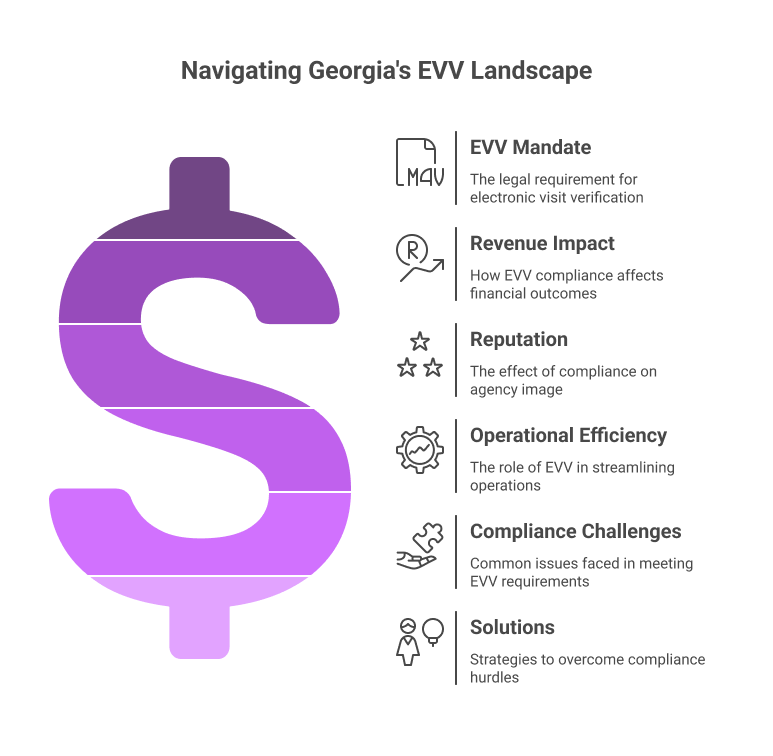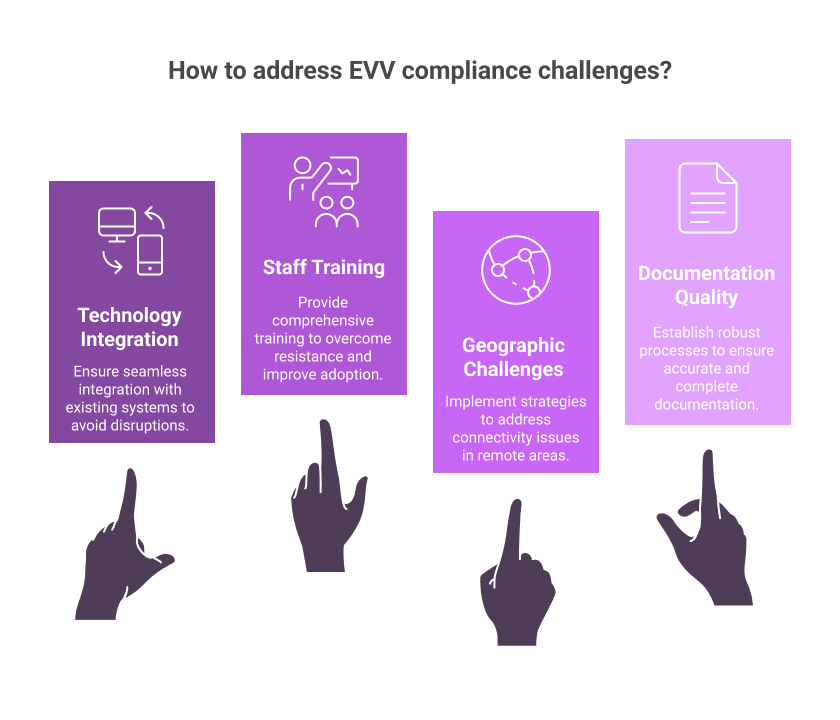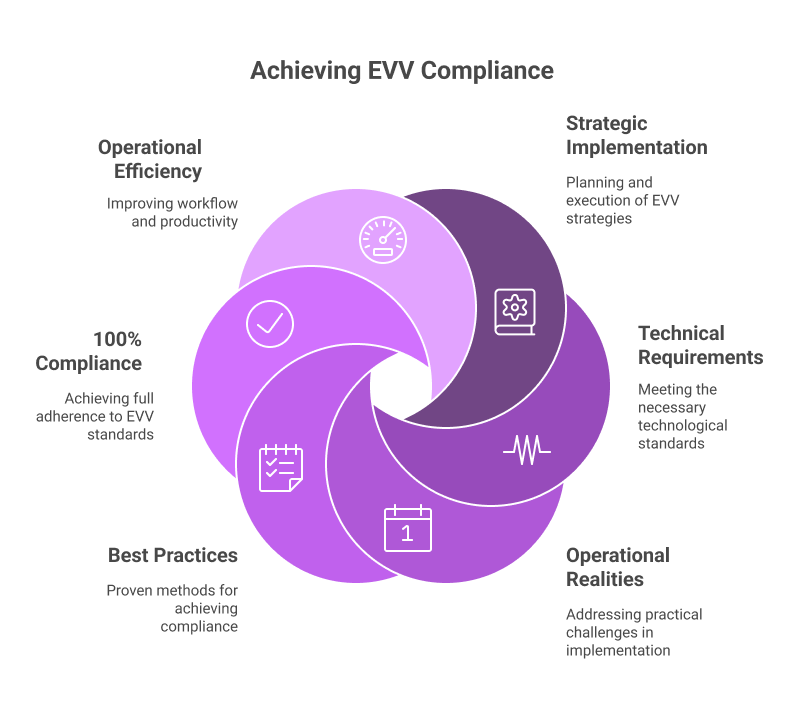Georgia GAPP EVV requirements have fundamentally transformed how pediatric home care providers operate across the state. The Electronic Visit Verification (EVV) mandate, implemented as part of the 21st Century Cures Act, isn’t just another compliance checkbox—it’s a critical component that directly impacts your agency’s revenue, reputation, and operational efficiency.
For Georgia Pediatric Program (GAPP) providers, understanding and implementing robust EVV systems has become essential for survival in today’s regulatory environment. The Georgia Department of Community Health (DCH) has established specific protocols that go beyond federal minimums, creating unique Georgia GAPP EVV requirements that affect every aspect of service delivery.
This comprehensive guide will walk you through everything you need to know about EVV compliance in Georgia’s pediatric home care landscape. We’ll explore the specific Georgia GAPP EVV requirements, common pitfalls, proven solutions, and real-world strategies that successful agencies use to maintain 100% compliance while actually reducing administrative burden.
Whether you’re a seasoned agency administrator or new to GAPP services, this guide provides the practical insights you need to transform EVV from a compliance headache into a competitive advantage.

Understanding Georgia’s Specific EVV Requirements
Georgia GAPP EVV requirements extend beyond the basic federal mandate to include specific data elements and verification protocols tailored to pediatric home care services. Understanding these nuances is crucial for maintaining compliance and avoiding costly claim rejections.
Core EVV Data Elements for GAPP Services
The Georgia Department of Community Health requires EVV systems to capture and transmit specific information for each service encounter. These Georgia GAPP EVV requirements include:
Mandatory Service Data Points:
- Beneficiary name and Medicaid ID number
- Service provider name and National Provider Identifier (NPI)
- Service location with GPS coordinates when applicable
- Service start and end times with precise timestamps
- Service type and billing codes specific to GAPP services
- Electronic signature or biometric verification of service delivery
GAPP-Specific Documentation Requirements: Georgia’s pediatric program adds additional layers to standard EVV protocols. Providers must document care plan adherence, medication administration records, and any changes in the child’s condition or care needs during each visit.
The system must also capture caregiver credentials verification, ensuring that each service is delivered by appropriately licensed and trained personnel. This is particularly critical in pediatric care where specialized skills and certifications may be required.
Real-Time vs. Batch Processing Requirements
Unlike some states that allow batch processing of EVV data, Georgia GAPP EVV requirements mandate real-time or near real-time data transmission. Service start and end times must be captured and transmitted within specific timeframes to maintain compliance.
This real-time requirement creates both challenges and opportunities for GAPP providers. While it demands more robust technology infrastructure, it also enables better operational oversight and immediate identification of service delivery issues.
Integration with Georgia’s Medicaid Management Information System (MMIS)
EVV data must integrate seamlessly with Georgia’s MMIS for claim processing and reimbursement. The state has established specific data formatting requirements and transmission protocols that differ from other states’ systems.
Providers must ensure their EVV systems can communicate effectively with Georgia’s infrastructure, including proper error handling and retry mechanisms for failed transmissions. This technical integration is often where agencies encounter unexpected compliance challenges.
Common EVV Compliance Challenges for GAPP Agencies
Even well-intentioned GAPP providers frequently struggle with EVV compliance due to common implementation and operational challenges. Understanding these pitfalls helps agencies proactively address potential issues before they impact reimbursement or compliance status.

Technology Integration Failures
Many agencies underestimate the complexity of integrating EVV systems with existing workflows and documentation processes. Georgia GAPP EVV requirements demand seamless integration between scheduling systems, clinical documentation platforms, and billing software.
Common Integration Issues:
- Data synchronization delays between systems
- Incompatible data formats causing transmission errors
- Duplicate or missing service records
- Inability to handle complex GAPP service combinations
These technical challenges often stem from attempting to retrofit EVV compliance onto existing systems rather than implementing comprehensive solutions designed for pediatric home care requirements.
Staff Training and Adoption Resistance
Field staff resistance to new EVV protocols represents one of the most persistent compliance challenges. Nurses and caregivers focused on patient care may view EVV requirements as administrative burden that detracts from their primary responsibilities.
Typical Staff Concerns:
- Additional time required for EVV documentation
- Technology complexity and user interface issues
- Fear of being monitored or micromanaged
- Concerns about accuracy of GPS tracking in certain locations
Successful EVV implementation requires comprehensive change management strategies that address these concerns while demonstrating the benefits of streamlined documentation and reduced administrative burden.
Geographic and Connectivity Challenges
GAPP services often extend to rural areas where cellular coverage may be spotty or unreliable. Georgia GAPP EVV requirements don’t excuse connectivity issues, creating compliance risks for agencies serving clients in remote locations. Understanding these geographic challenges is crucial for maintaining Georgia GAPP EVV requirements compliance.
Geographic Compliance Challenges:
- Inconsistent GPS accuracy in rural or mountainous areas
- Limited cellular data coverage affecting real-time transmission
- Indoor service locations with poor signal strength
- Weather-related connectivity disruptions
Agencies must develop contingency plans and backup procedures to maintain compliance even when primary EVV systems experience connectivity issues.
Documentation Quality and Completeness
Meeting Georgia GAPP EVV requirements involves more than just capturing start and end times. The quality and completeness of documentation significantly impact compliance status and reimbursement accuracy. Agencies must ensure their processes align with all Georgia GAPP EVV requirements to avoid penalties.
Common Documentation Deficiencies:
- Incomplete or inaccurate service descriptions
- Missing required signature or biometric verification
- Inadequate care plan correlation
- Failure to document significant events or changes in patient condition
These documentation gaps often result from rushed service delivery or inadequate understanding of specific GAPP requirements.
Best Practices for EVV Implementation
Successful EVV compliance requires strategic implementation that addresses both technical requirements and operational realities. These proven best practices help GAPP agencies achieve and maintain 100% compliance while improving overall operational efficiency.

Comprehensive Staff Training and Support
Effective EVV implementation begins with thorough staff education that goes beyond basic system operation. Training programs should address both technical skills and the underlying rationale for Georgia GAPP EVV requirements, ensuring staff understand the importance of compliance.
Essential Training Components:
- Detailed explanation of EVV requirements and their importance
- Hands-on system training with realistic scenarios
- Troubleshooting common issues and error resolution
- Regular refresher training and updates
- Peer mentoring and support systems
Training should be role-specific, recognizing that schedulers, field staff, and billing personnel have different EVV-related responsibilities and system interactions.
Robust Quality Assurance Processes
Maintaining EVV compliance requires ongoing monitoring and quality assurance processes that identify and correct issues before they impact reimbursement. Successful agencies implement multi-layered quality checks throughout their service delivery process.
Quality Assurance Framework:
- Real-time alerts for missing or incomplete EVV data
- Daily compliance dashboards and exception reports
- Weekly compliance audits and corrective action plans
- Monthly trend analysis and system performance reviews
- Quarterly comprehensive compliance assessments
These processes should be automated wherever possible to reduce administrative burden while maintaining thorough oversight.
Technology Selection and Implementation Strategy
Choosing the right EVV system requires careful evaluation of technical capabilities, integration requirements, and long-term scalability. Georgia GAPP EVV requirements demand specific functionality that not all EVV vendors provide, making vendor selection critical for compliance success.
Critical Technology Evaluation Criteria:
- Native integration with GAPP service requirements
- Real-time data transmission and error handling
- Mobile application usability and reliability
- Comprehensive reporting and analytics capabilities
- Vendor support and system maintenance reliability
Implementation should follow a phased approach that allows for testing, refinement, and staff adaptation before full deployment.
Workflow Integration and Process Optimization
EVV compliance works best when integrated seamlessly into existing clinical and administrative workflows. Rather than adding EVV as an additional step, successful agencies redesign their processes to incorporate EVV naturally into service delivery.
Workflow Integration Strategies:
- Combine EVV with clinical documentation processes
- Integrate scheduling and EVV systems for automatic data population
- Use EVV data to enhance care coordination and communication
- Leverage EVV analytics for quality improvement initiatives
This integrated approach transforms EVV from compliance burden into operational advantage.
How Automation Transforms EVV from Burden to Background Process
Modern EVV automation capabilities can completely transform the compliance experience for GAPP providers, shifting from manual documentation burden to seamless background processes that enhance rather than hinder service delivery. Advanced automation helps agencies meet Georgia GAPP EVV requirements effortlessly.
Intelligent Automation Features
Advanced EVV systems leverage artificial intelligence and machine learning to minimize manual data entry while ensuring comprehensive compliance with Georgia GAPP EVV requirements. These intelligent systems adapt to agency workflows while maintaining strict adherence to Georgia GAPP EVV requirements.
AI-Powered EVV Capabilities:
- Automatic service detection and time capture
- Predictive text and auto-completion for documentation
- Intelligent error detection and correction suggestions
- Automated compliance checking and validation
- Pattern recognition for anomaly detection
These features reduce the time required for EVV compliance while improving data accuracy and completeness.
Seamless Integration Ecosystems
The most effective EVV solutions integrate comprehensively with existing agency systems, creating unified workflows that eliminate duplicate data entry and reduce compliance risks.
Integration Benefits:
- Single sign-on access across all systems
- Automatic data synchronization between platforms
- Unified reporting and analytics dashboards
- Streamlined billing and reimbursement processes
- Consolidated staff training and support requirements
This ecosystem approach addresses Georgia GAPP EVV requirements while simultaneously improving overall operational efficiency.
Mobile-First Design for Field Staff
Field staff productivity and compliance depend on EVV systems designed specifically for mobile use in challenging care environments. Modern EVV platforms prioritize mobile functionality and offline capabilities.
Mobile EVV Advantages:
- Intuitive interfaces designed for touch interaction
- Offline functionality with automatic synchronization
- GPS and location services integration
- Biometric authentication capabilities
- Real-time communication with office staff
These mobile-first designs ensure that EVV compliance enhances rather than impedes quality care delivery.
Real-Time Analytics and Insights
Automated EVV systems provide real-time visibility into compliance status, service delivery patterns, and operational performance metrics that help agencies proactively address issues.
Analytics Capabilities:
- Live compliance dashboards and alerts
- Service delivery performance metrics
- Staff productivity and utilization analysis
- Client care pattern recognition
- Predictive compliance risk assessment
This real-time intelligence transforms EVV data from compliance requirement into strategic business intelligence.
Case Study: A GAPP Provider’s Journey to 100% EVV Compliance
Sunshine Pediatric Care, a mid-sized GAPP provider serving rural Georgia communities, struggled with EVV compliance for over two years before implementing a comprehensive automation solution. Their transformation illustrates the practical path from compliance challenges to operational excellence.
The Initial Challenge
Before implementing automated EVV systems, Sunshine Pediatric Care faced significant compliance challenges that threatened their participation in the GAPP program. Their struggles with Georgia GAPP EVV requirements were typical of many agencies attempting manual compliance processes.
Pre-Implementation Struggles:
- 23% claim denial rate due to EVV non-compliance
- Average of 15 hours per week spent on EVV-related administrative tasks
- Frequent audit findings and corrective action requirements
- Staff frustration and resistance to EVV documentation
- Client service disruptions due to administrative delays
These challenges resulted from attempting to meet Georgia GAPP EVV requirements using manual processes and disconnected systems that couldn’t effectively handle the complexity of pediatric home care services.
Implementation Strategy and Timeline
Sunshine Pediatric Care partnered with CareBravo to implement a comprehensive EVV automation solution tailored specifically to GAPP requirements. The implementation followed a structured 90-day timeline.
Phase 1 (Days 1-30): Foundation and Planning
- Comprehensive workflow analysis and process mapping
- Staff interviews and training needs assessment
- System configuration and integration testing
- Pilot program design and participant selection
Phase 2 (Days 31-60): Pilot Implementation
- Limited rollout with 25% of field staff
- Intensive training and support provision
- Daily monitoring and issue resolution
- Process refinement based on real-world feedback
Phase 3 (Days 61-90): Full Deployment
- Complete system rollout to all staff
- Comprehensive quality assurance implementation
- Performance monitoring and optimization
- Long-term support structure establishment
Results and Outcomes
The transformation achieved through automated EVV compliance exceeded Sunshine Pediatric Care’s expectations, delivering benefits that extended far beyond regulatory compliance.
Quantifiable Improvements:
- 99.7% EVV compliance rate within 90 days of full implementation
- 89% reduction in claim denials related to EVV issues
- 12 hours per week reduction in administrative overhead
- 34% improvement in staff satisfaction with documentation processes
- 28% faster billing cycle and improved cash flow
Qualitative Benefits:
- Enhanced client care coordination and communication
- Improved clinical documentation quality and completeness
- Increased staff confidence and job satisfaction
- Stronger relationships with state oversight agencies
- Competitive advantage in contract negotiations
Lessons Learned and Best Practices
Sunshine Pediatric Care’s success provides valuable insights for other GAPP providers facing similar EVV compliance challenges.
Critical Success Factors:
- Executive leadership commitment and staff buy-in from the beginning
- Comprehensive change management and communication strategies
- Phased implementation approach allowing for learning and adjustment
- Ongoing training and support beyond initial deployment
- Integration of EVV compliance into broader operational improvement initiatives
Common Pitfalls to Avoid:
- Underestimating the importance of staff training and support
- Attempting to implement EVV in isolation from other systems
- Focusing solely on compliance rather than operational improvement
- Inadequate testing and quality assurance processes
- Insufficient vendor support and ongoing maintenance planning
Conclusion: EVV as an Opportunity, Not Just a Requirement
Georgia GAPP EVV requirements represent more than regulatory compliance—they offer GAPP providers an opportunity to transform their operations, improve care quality, and achieve sustainable competitive advantages in the pediatric home care market.
Strategic Advantages of EVV Excellence
Agencies that excel at EVV compliance often discover unexpected benefits that extend far beyond meeting regulatory requirements.
Operational Excellence Benefits:
- Improved operational visibility and control
- Enhanced care coordination and communication
- Streamlined billing and reimbursement processes
- Better staff productivity and satisfaction
- Stronger client relationships and outcomes
Competitive Market Advantages:
- Higher contract award probability due to compliance track record
- Improved relationships with state oversight agencies
- Enhanced reputation among referral sources
- Better financial performance and cash flow management
- Increased scalability and growth potential
Building EVV Excellence into Your Agency Culture
Long-term EVV success requires embedding compliance excellence into agency culture rather than treating it as an external requirement.
Cultural Integration Strategies:
- Leadership commitment to compliance as core value
- Staff recognition and reward systems for compliance excellence
- Continuous improvement mindset and feedback culture
- Investment in ongoing training and technology upgrades
- Client-centered approach that views compliance as care quality enhancement
Future-Proofing Your EVV Strategy
The regulatory landscape continues to evolve, with increasing emphasis on data quality, interoperability, and outcome measurement. Successful GAPP providers prepare for future requirements while optimizing current compliance.
Future-Ready EVV Characteristics:
- Scalable technology platforms that can adapt to new requirements
- Comprehensive data analytics and reporting capabilities
- Integration readiness for emerging healthcare technologies
- Staff development programs that emphasize adaptability and continuous learning
- Strategic partnerships with technology vendors committed to innovation
Taking Action: Your Next Steps
Achieving EVV excellence requires deliberate action and strategic investment. Whether you’re struggling with current compliance or seeking to optimize existing systems, the path forward involves specific, measurable steps.
Immediate Action Items:
- Conduct comprehensive compliance assessment of current EVV processes
- Evaluate technology gaps and integration opportunities
- Develop staff training and support improvement plans
- Research advanced EVV automation solutions
- Create implementation timeline and success metrics
Long-Term Strategic Planning:
- Integrate EVV excellence into strategic business planning
- Develop technology roadmap aligned with agency growth goals
- Build relationships with compliance and technology experts
- Invest in staff development and retention programs
- Monitor industry trends and regulatory developments
The agencies that thrive in Georgia’s evolving GAPP landscape will be those that view EVV requirements as catalysts for operational excellence rather than compliance burdens. By embracing automation, investing in staff development, and maintaining focus on client care quality, GAPP providers can transform EVV compliance from administrative challenge into competitive advantage.
Eliminate EVV headaches with CareBravo Core. Our platform automatically handles verification, ensuring 100% compliance without added work. Transform your GAPP agency’s EVV processes from burden to competitive advantage with intelligent automation designed specifically for pediatric home care providers.
Request a Demo → | Learn More About Core Solutions →







